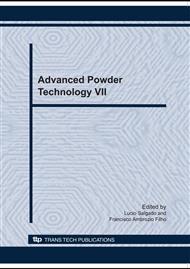p.954
p.959
p.965
p.971
p.977
p.983
p.989
p.995
p.1003
Synthesis of Nickel Oxide - Zirconia Composites by Coprecipitation Route Followed by Hydrothermal Treatment
Abstract:
Nickel oxide-yttria stabilized zirconia (NiO-YSZ) for use as solid oxide fuel cell anode were synthesized by coprecipitation to obtain amorphous zirconia and crystallized β-nickel gels of the corresponding metal hydroxides. Hydrothermal treatment at 200°C and 220 psi from 2 up to 16 hours, under stirring, was performed to produce nanocrystalline powder. The as-synthesized powders were uniaxially pressed and sintered in air. Powders were characterized by X-ray diffraction, laser scattering, scanning and transmission electron microscopy (SEM/TEM), gas adsorption technique (BET) and TG-DTA thermal analysis. Ceramic samples were characterized by dilatometric analysis and density measurements by Archimedes method. The characteristics of hydrothermally synthesized powders and compacts were compared to those produced without temperature and pressure application. Crystalline powders were obtained after hydrothermal process, excluding the calcination step from this route. The specific surface area of powders decreases with increasing time of hydrothermal treatment while the agglomerate mean size is not affected by this parameter.
Info:
Periodical:
Pages:
977-982
Citation:
Online since:
October 2010
Price:
Сopyright:
© 2010 Trans Tech Publications Ltd. All Rights Reserved
Share:
Citation:


